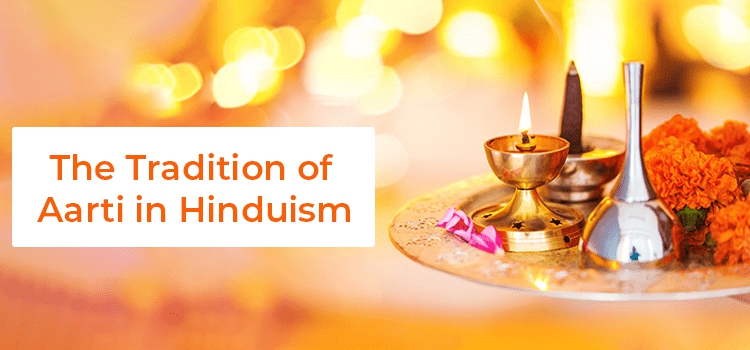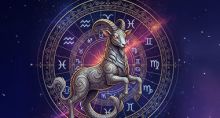The Tradition of Aarti in Hinduism
Aarti is an important tradition and ceremony in Hinduism. It is performed during worship and is both a greeting and thanksgiving to the deities who are being worshipped.
The tradition of Aarti is believed to have originated in the ancient Vedic fire rituals called Homa. Some believe that it arose from the ancient practice of illuminating a murti (idol) placed deep within the dark recess of a mandir’s inner sanctum, which resembled a cave. To enable devotees to get a glimpse of the deity, the priest would wave an oil lamp from the deity’s head to toe as he chanted Vedic Mantras or sang a prayer. Slowly, this practice evolved into the tradition of Aarti.
In Sanskrit, the word ‘aarti’ or ‘aarati’ has a prefix ‘aa’, meaning complete, and ‘rati’, which means ‘love’. Thus, it represents an expression of one’s complete devotion and love toward God. A deep sense of adoration, reverence, and meditative awareness accompanies the singing and the performance of Aarti. ‘Aarti’ may also have come from the Sanskrit term ‘Aratrika’” meaning ‘the process of offering light to deities’.
Aarti is also referred to as the ‘ceremony of light’. When performing Aarti, one waves lighted wicks before the idols of the deity so that the flames are infused with the deities’ energy, love, and blessings. The light from camphor is also used along with the flames from the wicks soaked in ghee. Water, incense, and flowers are some of the other auspicious articles offered during the ceremony. In some Aartis, people also wave a chamar (fan) or white cloth. All these represent the five elements of the world – space (white cloth), air (fan), light (flames), water, and earth (flowers). Together, they signify the offering of Creation in its entirety to the deity during the ceremony.

‘Aarti’ has another meaning as well. It is the prayer that is sung in praise of the deity while waving the wicks. The prayer is often sung to the accompaniment of musical instruments, like drums, bells, gongs, and a conch shell. The ceremony is often begun and concluded by blowing a conch shell. The priest or devotee may also ring a small hand bell during the Aarti ritual.
After the prayer, the priest passes the lighted wicks around the congregation so that those present can receive the blessings infused within the flames. People cup their downturned hands over the flame and then touch them to their eyes and head with reverence. With this gesture, the purificatory blessing conveyed from the deities to the flame passes on to the devotee.
The Five Kinds of Aarti
Aarti is performed five times a day at large, spired temples, where each Aarti relates to a specific part of the deities’ daily routine. The five common Aartis are Mangala Aarti at dawn (when the deities offer their first darshan to devotees); Shingar Aarti in the early morning (when the deities are clothed and adorned); Rajbhog Aarti at midday (after the deities have had their midday meal); Sandhya Aarti at dusk (when the deities offer evening darshan), and Shayan Aarti (when the deities are preparing to retire for the night).
At smaller temples and in households, Aarti takes place twice daily, in the morning and at dusk.
Aarti is also a part of other, more elaborate Hindu religious rituals and can also be the concluding prayer in religious assemblies and festivals.
Significance of Aarti
Like the wicks that burn in the service of the deities, devotees wish to selflessly offer themselves in the service of God. The wicks eventually burn out completely; similarly, the ego of the devotee is burned away through surrender to and service to God. Also, the wicks provide light and remove darkness. In the same way, true knowledge of God and the Guru removes evil, ignorance, and false understanding.
The lamp is a symbol of the human soul that seeks spiritual awakening and enlightenment. The Aarti’s circular motion and the waving of incense represent life’s cyclical nature and the cosmic dance.
A Multisensory Experience
The ritual of Aarti engages the senses of sight, sound, and smell. The lamp’s soft glow, the rhythmic chants, and the pleasant aroma of incense have a serene and uplifting effect on the mind. It deepens our connection with the divine.
The Mantras and bhajans are not mere sounds; they have profound meaning and arouse devotion within the worshipper’s heart, and bring them solace and strength.
Aarti at Festivals
The tradition of Aarti is also a part of various festivals. During Diwali, most parts of the country are lit up by millions of lamps to symbolize the victory of good over evil. During the Ganesh Chaturthi festival, the vibrant Aarti, when devotees send off Ganesha with grand processions and outpourings of love and devotion, is unforgettable.
Aarti as a Part of Daily Life
Families perform Aarti during special occasions, like welcoming guests or seeking blessings for their dear ones. It creates a sense of togetherness and helps instill reverence and faith in the younger generation.
Igniting Self-awareness
Aarti is a profound inner experience. During Aarti, we are impelled to look within ourselves and ignite the flame of self-awareness. It reminds us to fan the flame of devotion and reverence in our hearts constantly so that we become more spiritual, compassionate, and kind.



















